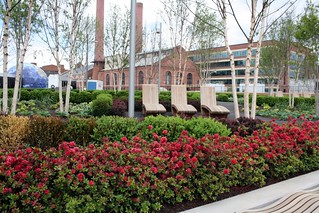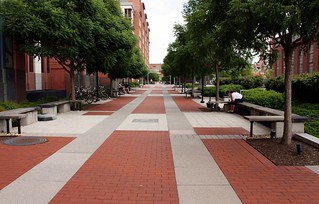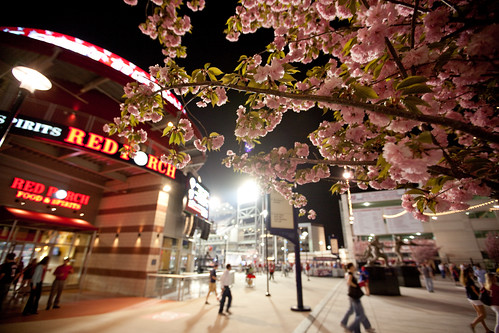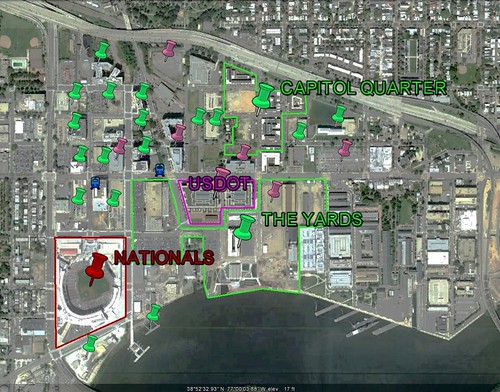'Baseball-oriented development' hits a home run in DC

Posted May 14, 2012 at 1:28PM
The neighborhood near Nationals Park, the baseball stadium in southeastern Washington, DC, is undergoing an amazing transformation. A decade ago, the federal Department of Transportation had made a hopeful commitment to the area with plans for a new headquarters, but by and large this part of town remained a sketchy no-man’s-land of outmoded and abandoned warehouses, industrial facilities and military properties. There were a small number of well-tended, older row houses but much of the area wouldn’t have looked out of place in a nighttime scene from The Wire or The Sopranos.
When the baseball stadium was being discussed as a proposal, the argument made by proponents was that it could be a catalytic boost to positive urban development in the neighborhood, much as the downtown basketball/hockey/entertainment arena Verizon Center has been. Opposition was fierce, of course, but eventually baseball was given its home in southeast Washington
Unfortunately, the stadium opened for business at the same time as the dawn of the Great Recession, which brought most real estate development in DC and elsewhere to a halt. It didn’t help that the team - the Washington Nationals, formerly the Montreal Expos - was awful. It seemed as if neither the Nats nor the neighborhood was turning out as hoped.
That was then. Just above is a satellite image of the area, in between the freeway and the Anacostia River. Everything marked in green represents the location of redevelopment projects approved since the city gave the go-ahead to the ballpark (marked in red) in 2004. Some of those projects are now finished; most are underway. (The sites marked in fuchsia represent redevelopment approved before the arrival of baseball to the neighborhood. The Metro station is marked in blue.)
Today, the team sits atop the National League East standings, with the best pitching in professional baseball as well as two of the game’s brightest young stars in Stephen Strasburg and Bryce Harper. Development has amped up to high gear.
The largest project is The Yards, an impressive and ambitious undertaking that when fully built will contain some 1.8 million square feet of office space,  400,000 square feet of retail and cultural spaces, 2,700 rental and forâ€sale homes, and a significant riverfront park and esplanade. The project’s walkable, transit-accessible plan has been certified LEED-ND gold and the adjoining park has won its own accolades. The second largest bit of redeveloped land in the sector is occupied by the new townhouse development Capitol Quarter, already sold out.
400,000 square feet of retail and cultural spaces, 2,700 rental and forâ€sale homes, and a significant riverfront park and esplanade. The project’s walkable, transit-accessible plan has been certified LEED-ND gold and the adjoining park has won its own accolades. The second largest bit of redeveloped land in the sector is occupied by the new townhouse development Capitol Quarter, already sold out.
Marc Fisher recently wrote in The Washington Post that the financial risks taken by the city are more than paying off:
“In the past three years, the ballpark fee, a tax levied on the city’s 1,800 largest businesses, has brought in $85 million, double what the city had projected. Sales taxes at the stadium have lagged behind estimates because of lower attendance, but the city’s overall take has been so strong that millions in excess collections have been used to balance the D.C. budget. The gusher of tax dollars will allow the District to pay off the 30-year stadium bonds as much as 12 years early, which will let the city scrap the business tax sooner than planned, [city economic development director John] Ross said.
“The city also is enjoying an increased flow of property taxes — about $13 million more per year so far — as land around the ballpark has grown much more valuable.
“’It took 10 or 12 years for the area around the Verizon Center to boom,’ Ross said. ‘The area around the baseball stadium is growing even faster.’”
Fisher writes that, according to developers in the area, building didn’t really become financially feasible there until the city committed to the ballpark. Today, the neighborhood’s new projects are about 30 percent built. In addition to the new commercial properties, the area’s residential population has increased from about 1,000 to more than 3,500 and should eventually reach 16,000.
It is especially heartening that even those originally opposed to the stadium like what they see. Neighborhood resident Naomi Monk was a prominent skeptic, arguing that the park would only be an eyesore benefiting millionaire players and businessmen, with nothing in it for low-income residents. But in March she told Fisher that “I have to say, it’s been for the betterment of the community. Our crime seems to be under control. The neighborhood looks 100 percent better. The new housing is a great improvement.”
Similarly, Gloria Sligh, who has lived in the area for 31 years, told Fisher that “The stadium brought down the color barrier some. We mingle more.” City council member Jim Graham, who voted against the stadium eleven times,  now says that Nationals Park has indeed been transformational for the area and that spending city money for sports facilities makes sense in situations where the city can get a new neighborhood as a result.
now says that Nationals Park has indeed been transformational for the area and that spending city money for sports facilities makes sense in situations where the city can get a new neighborhood as a result.
I’m not going to make a broader point about the extent to which public investment in sports is a good thing. It’s likely situational and, though it has been enormously beneficial here in Washington twice (though in the case of Verizon Center the city paid only for infrastructure), and it also appears to have been beneficial in nearby Baltimore, the facts and circumstances vary.
Mostly, I am just elated that baseball is making a positive difference in the city I care about most. I’m also happy that the team is winning.
Related posts:
- Solving sprawl with basketball (reprise) (February 28, 2011)
- A second winner at this year's Super Bowl: the walkable downtown (February 10, 2012)
- A spiffy green waterfront begins to take shape in DC (January 19, 2012)
- The greening of professional sports (November 17, 2010)
- Dublin gets spectacular green stadium (June 3, 2010)
Move your cursor over the images for credit information.
Please also visit NRDC’s Sustainable Communities Video Channel.

